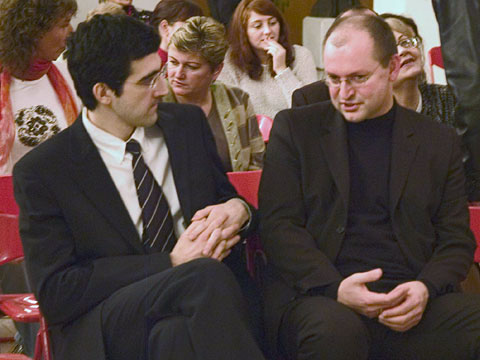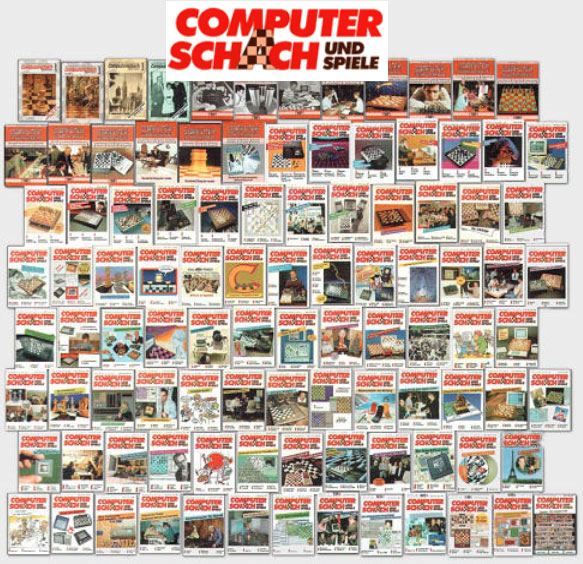 You all know Christian Hesse. He is a professor of mathematics with a chair in Stuttgart University (and sometimes Santa Barbara). He is also a prolific author who has published some of the most popular books on mathematics in Germany. Christian has also written a couple of well-received books on his special hobby, chess. And he has contributed to a large number of articles on our news page. On the right you see him, chatting with a friend.
You all know Christian Hesse. He is a professor of mathematics with a chair in Stuttgart University (and sometimes Santa Barbara). He is also a prolific author who has published some of the most popular books on mathematics in Germany. Christian has also written a couple of well-received books on his special hobby, chess. And he has contributed to a large number of articles on our news page. On the right you see him, chatting with a friend.
 Me? I started editing this news page in its database form twenty years ago, incidentally on September 12, 2001. On page 734 of our index you can see how it all started – and perhaps read the first article there. Very poignant.
Me? I started editing this news page in its database form twenty years ago, incidentally on September 12, 2001. On page 734 of our index you can see how it all started – and perhaps read the first article there. Very poignant.
Before ChessBase.com I edited a German language magazine on computer games and chess. Computerschach & Spiele ran from 1983 to 2004, with over 120 issues. In it, I penned many hundreds of articles, many of which today have historical value. A number of the most interesting ones will flow into the book Christian and I are writing, of course with careful editing and updated bring them into current times.
Another thing we will do is to make all the games, moves and analyses replayable on your smartphone. For this we use QR codes, as described in this article: The future of chess books. Christian has already tried and tested the technology in his book "Damenopfer".
Naturally there will also be a lot of new material, fresh articles written directly for the book. And this, dear readers, is where you come in. We will be conducting experiments on this news page to see how people react to our chess problems, puzzles and stories. Today we start with what we call "Chess Logicals", problems that merge chess and logic in general.
The Zen Chess Logical
This logical problem was created by Christian Hesse, and is typical for his way of thinking. A Zen master visits a chess club and sees two students studying a chess position:
After watching for a while the Zen master says: "I see that one of the men on the board will, in the course of the solution, make a very deep move!"
"Which one," the students want to know.
"I'll tell you, Kaito, the piece type, and you, Toshi, the colour." He whispers this into their ears.
Toshi is the first to react: "There is no way either of us could deduce which piece you mean."
To which Kaito says: "Okay, now I know which piece it is!"
Toshi: "Aha, then I know as well."
The chess logical is for our readers to find out which piece the Zen master meant, and how Kaito and Toshi could deduce it.

An important note: the process of deducing the piece has nothing to do with the chess content of the position. Kaito and Toshi could have deduced it even if the pieces were not standing in a meaningful position, but simply lined up on the table, next to each other.
Having said that the study on the board happens to be very meaningful. One of the people we tested the Chess Logical on was John Nunn, who solved it in just a few seconds. "Pity about the actual position, though," he said. "It could at least have been an interesting study." But an hour later he wrote "Actually, I was a bit rude. I didn’t see Black’s main attacking idea. It’s actually quite a nice study."
So here is the second task for our readers: in the diagram position above, which was given to us by Dr Karsten Müller (to match the Chess Logical material), it is White to play and draw. Warning: the solution is quite hard, especially if you see the best black attack.
Currently, a number of very strong players, as well as young super-talents, are working on the logical part of the problem, so please do not post the solution in the feedback section below – just whether you were able to solve it (and the study), how long it took, and whether you like this kind of puzzle.
The solution to the Logical and the study will be published next week. Until then: have fun!


















 You all know Christian Hesse. He is a professor of mathematics with a chair in Stuttgart University (and sometimes Santa Barbara). He is also a prolific author who has published some of the most popular books on mathematics in Germany. Christian has also written a couple of well-received books on his special hobby, chess. And he has contributed to a large number of
You all know Christian Hesse. He is a professor of mathematics with a chair in Stuttgart University (and sometimes Santa Barbara). He is also a prolific author who has published some of the most popular books on mathematics in Germany. Christian has also written a couple of well-received books on his special hobby, chess. And he has contributed to a large number of  Me? I started editing this news page in its database form twenty years ago, incidentally on September 12, 2001.
Me? I started editing this news page in its database form twenty years ago, incidentally on September 12, 2001. 





